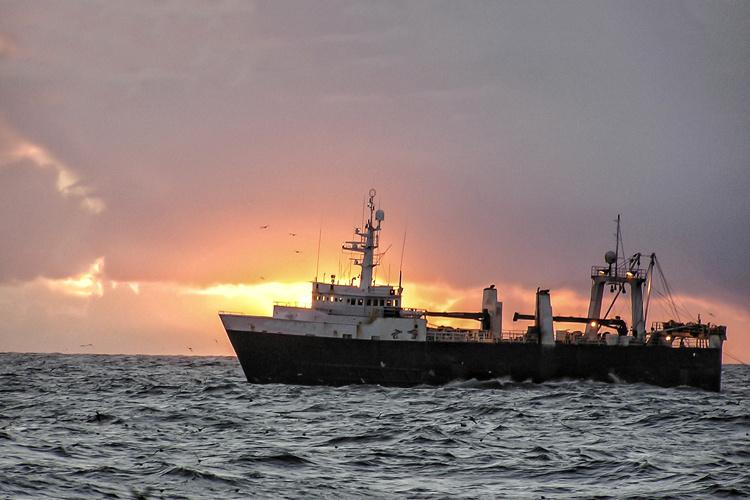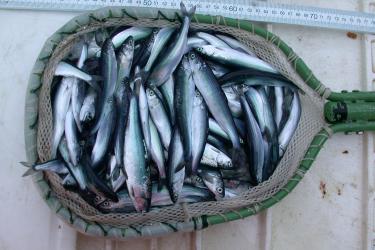Collecting & Analyzing Data

Seasonal vessel surveys are conducted to monitor abundance, size and distribution of key commercial fish and crab species when they are at the adult, juvenile, larvae and egg stages of life. We collect fish stomachs to learn more about fish diets and predator-prey relationships. We collect fish otoliths (i.e., ear bones) to determine fish ages, reproductive ages, and the different age groups that make up a given fish population. We also gather a variety of information on ecological processes—the physical, chemical and biological actions or events that link organisms and their environment. For instance, we monitor oceanographic conditions including water temperature and visibility at depth, nutrient levels, and estimates of the composition and biomass of plankton.
We conduct analyses and experiments to examine behavior, genetics to determine stock structure, and energy requirements for fish growth and development in our laboratories. An emerging area of study is to look at the impact of ocean acidification on the development, growth and survival of different age fish and crab species.
We also are involved in a variety of similar research on marine mammals such as whales, seals, sea lions and porpoises in Alaska.
Another important area of ecosystem research for the Center is collecting and analyzing economic and socio-cultural data. We help managers evaluate the economic and cultural impacts of management alternatives, ensuring sustainable commercial, recreational and subsistence communities and healthy functioning marine ecosystems.

A Rougheye rockfish.
Ecosystem Status Reports
For nearly 25 years, we have compiled and summarized data collected by Center scientists, other NOAA offices, federal and state agencies and academia annually in Ecosystem Status Reports for the North Pacific Fishery Management Council, the scientific community and the public. Status reports are prepared for the Eastern Bering Sea (updated 2021), Aleutian Islands (updated 2021), the Gulf of Alaska (updated 2021), and Arctic (now known as the NOAA Arctic Report Card) ecosystems.
Included in the status reports are ecosystem report cards, which summarize trends in regularly monitored ecosystem indicators (e.g., biological, ecological, socio-cultural and economic) and assessments, which provide narratives about the state of the ecosystems. Monitoring ecosystem indicators provides an early warning system for managers, signaling human or climate-induced changes that may warrant management action. With these indicators we can track the success of previous management efforts for single species and ecosystems.
Ecosystem Modeling

We input all the data from our field and laboratory studies into computer models to help us understand and ultimately predict how fish, crabs, fisheries and communities will respond under different environmental conditions. Resource managers use this information to develop groundfish management measures each year. With the help of computer models we are able to understand ecosystem productivity, including direct and indirect effects of fishing on food webs and habitat. We can identify trade-offs between different ecosystem uses so managers can make strategic decisions to promote sustainability. Our goal is to advance our forecasting capabilities to help resource managers better anticipate and respond to changes that may be coming in the near term and long term for groundfish and other species.
Partnerships Key to Success of Alaska Ecosystem Research
Interdisciplinary partnerships are key to the success of our ecosystem research efforts. Most of our egg, larval and juvenile fish and oceanographic studies are conducted through a cooperative research effort known as the Recruitment Processes Alliance (RPA), which is made up of three programs: Recruitment Processes, Ecosystem Monitoring and Assessment, and Research Energetic and Coastal Assessment. The RPA is a NOAA Fisheries - NOAA Research partnership whereby scientists work together across disciplines to monitor ecosystem changes, conduct process research, direct laboratory investigations, and develop models to integrate results and forecast impacts. Studies span all trophic levels, including interactions among the physical environment, phytoplankton, zooplankton, fish dynamics, seabirds, mammals, and humans. The oceanographic component of RPA work takes place as part of a related cooperative research effort known as the Ecosystems and Fisheries Oceanography Coordinated Investigations program (EcoFOCI), involving the Alaska Fisheries Science Center and the Pacific Marine Environmental Laboratory of NOAA’s Office of Oceanic and Atmospheric Research.
The Center leverages its resources through partnerships in regional research programs involving the North Pacific Research Board, the North Pacific Anadromous Fish Commission’s Bering Aleutian Salmon International Survey (BASIS), the Bering Sea Fisherman’s Association, the Alaska Sustainable Salmon Fund, and the Arctic Yukon Kuskokwim Sustainable Salmon Fund. The Center also partners with national programs, including the NOAA Loss of Sea Ice Program, which has supported a new survey in the northern Bering Sea in 2010 and 2017.
Data from these surveys have been used in the North Pacific Research Board’s Bering Sea Ecosystem Integrated Research Program research activities, reports, and publications, available on the Alaska Ocean Observing System (AOOS) website. Data obtained through partnerships are also used to describe the likely distribution of deep sea corals and to designate essential fish habitat for the Pacific Council.
To date, we have participated in three Integrated Ecosystem Research Programs (Bering Sea 2007-2015, Gulf of Alaska 2010-present, and Arctic 2016-present) in partnership with the around these ecosystems. We also have developed a three-year plan (2017-2019) that identifies priorities for integrated ecosystem research for the five Alaska marine ecosystems.
In particular, Integrated ecosystem research is ongoing or planned for key species and regions including Arctic cod in the eastern Chukchi Sea, walleye pollock and Pacific cod in the southeastern Bering Sea, and western Gulf of Alaska, and to conduct research on sablefish in the eastern Gulf of Alaska. Additionally, resource managers and scientists working with NOAA Fisheries Alaska Fisheries Science Center are developing a Bering Sea Fisheries Ecosystem Plan.

Predicting Short Term and Long Term Ecosystem Changes
We study ecosystem changes through projects like the Alaska Climate Integrated Modeling Project (ACLIM) project. This multi-disciplinary research project pulls together socio-economic, biological and climate models, field data, and ecosystem status reports to better predict and respond to environmental changes that may be taking place in the Bering Sea. Understanding the effectiveness of current management approaches under different climate scenarios and how this will affect both fish and fishermen is critical to forecasting changes in commercially valuable species and maintaining sustainable fisheries and communities in Alaska.
The Center is collaborating with the Pacific Marine Environmental Laboratory, the University of Washington Joint Institute for the Study of Atmosphere and Ocean (JISAO) and School of Aquatic and Fishery Sciences (SAFS) and the Norwegian Institute for Water Research (NIVA) on this project.
Additional Resources
- Forecasting Pink Salmon Harvest in Southeast Alaska
- Alaska Marine Ecosystem Status Reports
- Alaska Ecosystem Models
- Resource Ecology and Fisheries Management Division Trophics Interactions Meta Data
- Understanding Ecosystem Processes in the Bering Sea
- Ecosystem and Recruitment Process Research in Alaska
- Zooplankton Distribution and Abundance Studies in Alaska
- Ecology of Small Fish Living in the Shallow Waters (Neritic Zone) of the Gulf of Alaska
- Alaska Ichthyoplankton Information System Database



